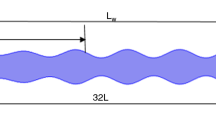Abstract
Heat exchange devices involving confined heated cylinders in crossflow require wake stability to minimize hydraulic losses, which are typically accompanied by a considerable loss in heat transfer. To address this problem, passive wake control for laminar flow past a cylinder is introduced in the form of wavy channel walls around the cylinder. The resultant effects on heat transfer and drag are investigated in detail for a range of Reynolds numbers (Re = = 20–200), blockage ratios (β = 0.5–0.9) and Prandtl numbers (Pr = 0.25–100). For the given range of parameters, it is shown that the wavy channel reduces cylinder drag by a minimum of ∼ 36 % and a maximum of ∼ 95 %, at the expense of ∼ 8 % and ∼ 40 % loss in heat transfer, respectively, compared to the plane channel. Thermal-hydraulic performance of the wavy channel compared to the plane channel for Pr = 0.744, is improved by ∼ 14 % for β = 0.5 and ∼ 160 % for β = 0.9. Therefore, the performance enhancement brought about by the wavy channel provides an appropriate trade-off between drag reduction and heat transfer loss.
Similar content being viewed by others
Availability of Data
The data that supports the findings of this study, along with the neural network code and the trained model are available from the corresponding author upon a reasonable request.
References
D.S. Steinberg, Cooling techniques for electronic equipment, 2nd ed., Wiley, New York, 1991, 483 p.
Y. Yener, S. Kakac, M. Avelino, and T. Okutucu, Single-phase forced convection in microchannels, Microscale Heat Transfer Fundamentals and Applications, 2005, P. 1–24.
F.V. Castelloes, J.N. Quaresma, and R.M. Cotta, Convective heat transfer enhancement in low Reynolds number flows with wavy walls, Inter. J. Heat Mass Transfer, 2010, Vol. 53, No. 9–10, P. 2022–2034.
M. Kaazempur-Mofrad, S. Wada, J. Myers, and C. Ethier, Mass transport and fluid flow in stenotic arteries: axisymmetric and asymmetric models, Inter. J. Heat Mass Transfer, 2005, Vol. 48, No. 21–22, P. 4510–4517.
P.E. Dimotakis, Turbulent mixing, Annual Review of Fluid Mechanics, 2005, Vol. 37, P. 329–356.
S. Jegatheeswaran, F. Ein-Mozaffari, and J. Wu, Efficient mixing of yield-pseudoplastic fluids at low Reynolds numbers in the chaotic SMX static mixer, Chem. Engng J., 2017, Vol. 317, P. 215–231.
H. Meng, X. Jiang, Y. Yu, Z. Wang, and J. Wu, Laminar flow and chaotic advection mixing performance in a static mixer with perforated helical segments, Korean J. Chem. Engng, 2017, Vol. 34, No. 5, P. 1328–1336.
L. Lin, J. Zhao, G. Lu, X.-D. Wang, and W.-M. Yan, Heat transfer enhancement in microchannel heat sink by wavy channel with changing wavelength/amplitude, Inter. J. Thermal Sci., 2017, Vol. 118, P. 423–434.
M. Sahin and R.G. Owens, A numerical investigation of wall effects up to high blockage ratios on two-dimensional flow past a confined circular cylinder, Phys. Fluids, 2004, Vol. 16, No. 5, P. 1305–1320.
S. Singha and K. Sinhamahapatra, Flow past a circular cylinder between parallel walls at low Reynolds numbers, Ocean Engng, 2010, Vol. 37, No. 8–9, P. 757–769.
J. Chakraborty, N. Verma, and R. Chhabra, Wall effects in flow past a circular cylinder in a plane channel: a numerical study, Chem. Engng Processing: Process Intensific., 2004, Vol. 43, No. 12, P. 1529–1537.
B. Rajani, A. Kandasamy, and S. Majumdar, Numerical simulation of laminar flow past a circular cylinder, Applied Math. Modeling, 2009, Vol. 33, No. 3, P. 1228–1247.
K. Lam and Y. Lin, Drag force control of flow over wavy cylinders at low Reynolds number, J. Mech. Sci. Tech., 2007, Vol. 21, No. 9, P. 1331.
R. Deepakkumar, S. Jayavel, and S. Tiwari, Cross flow past circular cylinder with waviness in confining walls near the cylinder, J. Applied Fluid Mech., 2017, Vol. 10, No. 1, P. 183–197.
M. Fiebig and Y. Chen, Heat transfer enhancement by wing-type longitudinal vortex generators and their application to finned oval tube heat exchanger elements, Heat Transfer Enhanc. Heat Exchangers, 1999, P. 79–105.
M. Cheraghi, M. Raisee, and M. Moghaddami, Effect of cylinder proximity to the wall on channel flow heat transfer enhancement, Comptes Rendus M’ecanique, 2014, Vol. 342, No. 2, P. 63–72.
S. Mettu, N. Verma, and R. Chhabra, Momentum and heat transfer from an asymmetrically confined circular cylinder in a plane channel, Heat and Mass Transfer, 2006, Vol. 42, No. 11, P. 1037–1048.
K. Jambunathan, S. Hartle, S. Ashforth-Frost, and V. Fontama, Evaluating convective heat transfer coefficients using neural networks, Inter. J. Heat Mass Transfer, 1996, Vol. 39, No. 11, P. 2329–2332.
M. Milano and P. Koumoutsakos, Neural network modeling for near wall turbulent flow, J. Comput. Physics, Vol. 182, No. 1, P. 1–26.
M. Raissi, A. Yazdani, and G. E. Karniadakis, Hidden fluid mechanics: Learning velocity and pressure fields from flow visualizations, Science, 2020, Vol. 367, No. 6481, P. 1026–1030.
M. Abadi, A. Agarwal, P. Barham, E. Brevdo, Z. Chen, C. Citro, G.S. Corrado, A. Davis, J. Dean, M. Devin et al., Tensorflow: large-scale machine learning on heterogeneous distributed systems, 2016, arXiv preprint arXiv: 1603.04467, P. 265–283.
J.-H. Chen, W. Pritchard, and S. Tavener, Bifurcation for flow past a cylinder between parallel planes, J. Fluid Mech., 1995, Vol. 284, P. 23–41.
Author information
Authors and Affiliations
Corresponding author
Rights and permissions
About this article
Cite this article
Ahmed, H.F., Malik, F.K. & Khan, M.M. Influence of passive wake control on thermal-hydraulic performance of a cylinder confined in wavy channel under high blockage ratios. Thermophys. Aeromech. 29, 357–371 (2022). https://doi.org/10.1134/S0869864322030040
Received:
Revised:
Accepted:
Published:
Issue Date:
DOI: https://doi.org/10.1134/S0869864322030040




